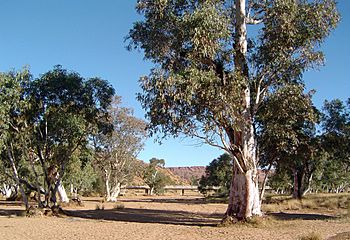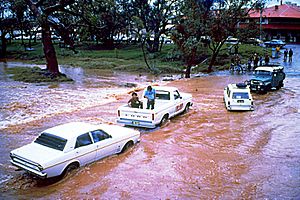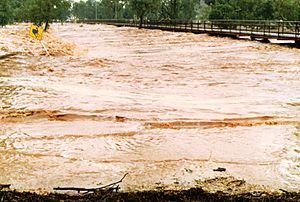Todd River facts for kids
Quick facts for kids Todd River |
|
|---|---|

The dry riverbed of the Todd River
|
|
| Country | Australia |
| Physical characteristics | |
| Main source | MacDonnell Ranges |
| Basin features | |
| Basin size | 445 km2 (172 sq mi) |
The Todd River is a special river in the southern Northern Territory of central Australia. It's known as an ephemeral river. This means it only flows with water sometimes, usually after heavy rain. For most of the year, its riverbed is dry.
The Todd River starts in the MacDonnell Ranges. It flows past the historic Alice Springs Telegraph Station and right through the middle of Alice Springs. Then it goes through a gap in the mountains called Heavitree Gap. After that, it continues into the western part of the Simpson Desert. Eventually, its water joins the Hale River and flows all the way to Lake Eyre in South Australia.
The local Arrernte people have their own name for this river: Lhere Mparntwe (pronounced ler-ra m-barn-twa).
This part of Australia is very dry, so the Todd River usually has no water. When it does flow, the water looks like milky chocolate. This is because it picks up a lot of mud and dirt from the land around it.
The Todd River got its English name from a surveyor named W. W. Mills. He named it after Charles Todd. Charles Todd was important for building the Australian Overland Telegraph Line, which was a big communication line across Australia.
Why the Todd River is Important to Alice Springs
The Todd River is very important to the town of Alice Springs. The main part of Alice Springs is built right next to the river. A large area of the town is actually on a flood plain. This flood plain was created by the river flooding upstream of the Heavitree Range.
The Todd River flows south through the Heavitree Range at Heavitree Gap. The main road and railway connecting Alice Springs to Adelaide also go through this gap. When the Todd River floods heavily, it can block these roads and railway lines. The narrow gap can also cause water to build up and flood many parts of the town.
It can be dangerous when the river floods. Sometimes, people camp in the dry riverbed. But heavy rains far upstream can make the river flow very quickly and unexpectedly. This means the water can rise fast, which can be risky.
When it rains a lot north of Alice Springs, the river starts flowing through the town about 6 to 8 hours later. The river can go from being completely dry to full of water in just 15 minutes! You can even walk alongside the leading edge of the water as it moves through town.
The riverbed is also special to the local Arrernte people. It has sacred sites and trees. These are linked to their Yeperenye (Caterpillar) Dreaming stories. Some old red-river gum trees in the river represent Kwekatja, who are young boys following the river north.
Fun Events and Activities on the River
One of the most famous events is the Henley-on-Todd Regatta. This funny race has been held in Alice Springs every year since 1961. It's special because it happens on the dry riverbed! Up to 20,000 people come to watch. The "boats" don't have bottoms. Competitors pick them up and run down the course inside them. The race even has insurance in case there's actually water in the riverbed! The Henley-on-Todd Regatta was only cancelled once, in 1993, because there was too much water in the river for the race.
Other events also happen in the dry riverbed. For example, the closing ceremony for the 2006 Alice Festival was held there. It's against the rules to camp in the riverbed, but this rule is not always strictly enforced.
When the river does flow, it's a big event for the people of Alice Springs. They rush to the bridges and the Telegraph Station to play in the water. Even though the riverbed is wide and mostly flat through town, the muddy water can hide dangers. There can be trees, things carried by the water, and other hazards. So, playing in the flowing river can be risky.
Upstream from Alice Springs, the Todd River drops quite quickly. It goes down 100 meters over about 8 kilometers of river length. This area is hilly, and the riverbed is full of rocks. This creates exciting rapids when the river floods. Some local people are careful around these waters. However, some local kayakers have recently started to paddle this section of rapids.



